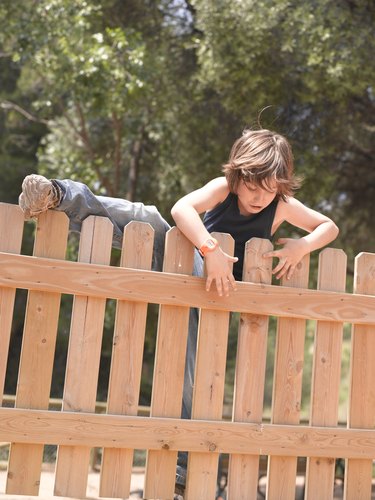
Wood expands and contracts in response to changes in temperature and moisture. In a protected space, such as a tongue-and-groove wood floor, dimensions change only a little. Hardwood floors need at least 12 mm of expansion gap, plus extra joints for large spans, according to the Timber Building in Australia website. In the outdoors, the movement of wood increases. Swelling boards could damage the fence unless builders include expansion gaps.
Wood Movement
Video of the Day
The vertical planks in a fence built without gaps fit neatly together until rain or humid weather puts extra moisture into the wood. The length of the boards changes very little, but the width and shape of the boards shifts enough to weaken the fence. Wood has radial grain structure, with more pores in the outer grain layers than in the inner grain. As fibers swell, the outer grain layers expand wider than the inner grain does, causing the board to cup or warp. A radial movement of 4 percent can cause a tangential movement -- the change in shape -- of up to 14 percent, according to the Arkansas Forest Resources Center.
Video of the Day
Radial Effects
As the width of the planks increases due to radial expansion, the planks exert pressure against each other. Swelling wood creates so much pressure that ancient stonemasons used wooden wedges to split stone by pouring water on dry wedges hammered into holes. In a fence, the pressure of the swelling planks bows the fence rails outward. The movement loosens the connection of horizontal rails to the fence posts and can cause posts themselves to shift out of line. As weather changes force expansion and contraction, the structure of the fence weakens. Fences built without gaps eventually fall.
Cupping
During construction, a kiln-dried board should fit flat against the horizontal rail. Spacing screws or nails correctly prevents some distortion, but weathering gradually works the boards loose. If a board cups toward the rail, the curve lifts the center away from the rail. Placing boards flush together combines that tangential force with the horizontal or radial expansion. As boards push against each other's edges, the planks pull farther away from the rail. Screws and nails that do hold can sink gradually deeper into the plank. Repeated cycles of weathering stresses pry the individual planks off the fence.
Wind Resistance
Wind pressure on a wood fence increases disproportionately to wind speed. A 30 mph wind exerts nine times as much force on a fence as a 10 mph wind, according to Purdue University Extension. As fence height increases, wind leverage forces also increase. A tall privacy fence built without gaps could fail in the first storm. From 25 to 50 percent of the fence should consist of open space. Fences with 2 to 2 1/2 inches of gap between 8- to 10-inch-wide planks offer better wind protection than solid walls. Shadowbox fences with planks on both sides of the fence, staggered to block the view through gaps, block wind and provide privacy.
- Timber Building in Australia: T & G Strip Floor: Expansion Joints at Wall and Between Boards
- Arkansas Forest Resources Center: Wood & Water
- Purdue University Cooperative Extension Service: Wind and Snow Control Around the Farm
- University of Tennessee Extension: Planning & Building Fences on the Farm